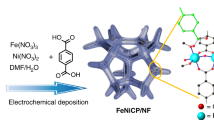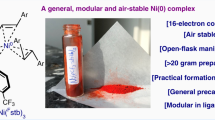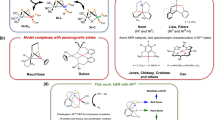Abstract
Nickel has been found in some metalloproteins that execute catalytic aerobic oxygenation reactions in which nickel–dioxygen species are proposed as the key catalytic species. Thus, various nickel–dioxygen complexes have been prepared for biomimetic oxygenation reactions over the past 50 years, but they have often been used stoichiometrically rather than catalytically. The typical inertness of Ni(ii) complexes toward O2 poses a considerable challenge for their application in catalytic aerobic oxygenation. Here, we report a strategy to enable catalytic oxygenation with a simple Ni(ii)–bipyridine complex in which electrochemistry is employed to drive the cascade-activation process for the generation of both active Ni(ii)–peroxo species and O2 for the subsequent oxygenation reaction. We anticipate that this strategy will inspire the development of efficient nickel-catalysed aerobic oxygenations and promote the exploration of transition-metal-based oxidation chemistry in combination with electrochemistry.

This is a preview of subscription content, access via your institution
Access options
Access Nature and 54 other Nature Portfolio journals
Get Nature+, our best-value online-access subscription
$29.99 / 30 days
cancel any time
Subscribe to this journal
Receive 12 digital issues and online access to articles
$119.00 per year
only $9.92 per issue
Buy this article
- Purchase on Springer Link
- Instant access to full article PDF
Prices may be subject to local taxes which are calculated during checkout




Similar content being viewed by others
Data availability
The data that support the findings of this study, including experimental procedures and compound characterization, are available in the online version of this paper in the accompanying Supplementary Information, or available from the authors upon reasonable request.
References
Barondeau, D. P., Kassmann, C. J., Bruns, C. K., Tainer, J. A. & Getzoff, E. D. Nickel superoxide dismutase structure and mechanism. Biochemistry 43, 8038–8047 (2004).
Jeoung, J.-H., Nianios, D., Fetzner, S. & Dobbek, H. Quercetin 2,4-dioxygenase activates dioxygen in a side-on O2–Ni complex. Angew. Chem. Int. Ed. 55, 3281–3284 (2016).
Cho, J. et al. Geometric and electronic structure and reactivity of a mononuclear ‘side-on’ nickel(III)–peroxo complex. Nat. Chem. 1, 568–572 (2009).
Cho, J. et al. Mononuclear nickel(II)-superoxo and nickel(III)-peroxo complexes bearing a common macrocyclic TMC ligand. Chem. Sci. 4, 1502–1508 (2013).
Panda, C. et al. Nucleophilic versus electrophilic reactivity of bioinspired superoxido nickel(II) complexes. Angew. Chem. Int. Ed. 57, 14883–14887 (2018).
Fujita, K. et al. A monomeric nickel–dioxygen adduct derived from a nickel(I) complex and O2. Inorg. Chem. 43, 3324–3326 (2004).
Yao, S., Bill, E., Milsmann, C., Wieghardt, K. & Driess, M. A ‘side-on’ superoxonickel complex [LNi(O2)] with a square-planar tetracoordinate nickel(II) center and its conversion into [LNi(μ-OH)2NiL]. Angew. Chem. Int. Ed. 47, 7110–7113 (2008).
Yao, S. et al. O–O bond activation in heterobimetallic peroxides: synthesis of the peroxide [LNi(μ,η2:η2-O2)K] and its conversion into a bis(μ-hydroxo) nickel zinc complex. Angew. Chem. Int. Ed. 48, 8107–8110 (2009).
Pietrzyk, P., Podolska, K., Mazur, T. & Sojka, Z. Heterogeneous binding of dioxygen: EPR and DFT evidence for side-on nickel(II)–superoxo adduct with unprecedented magnetic structure hosted in MFI zeolite. J. Am. Chem. Soc. 133, 19931–19943 (2011).
Duan, P.-C., Manz, D.-H., Dechert, S., Demeshko, S. & Meyer, F. Reductive O2 binding at a dihydride complex leading to redox interconvertible μ-1,2-peroxo and μ-1,2-superoxo dinickel(II) intermediates. J. Am. Chem. Soc. 140, 4929–4939 (2018).
Holze, P. et al. Activation of dioxygen at a Lewis acidic nickel(II) complex: characterization of a metastable organoperoxide complex. Angew. Chem. Int. Ed. 56, 2307–2311 (2017).
Otsuka, S., Nakamura, A. & Tatsuno, Y. Oxygen complexes of nickel and palladium. Formation, structure, and reactivities. J. Am. Chem. Soc. 91, 6994–6999 (1969).
Lanci, M. P., Brinkley, D. W., Stone, K. L., Smirnov, V. V. & Roth, J. P. Structures of transition states in metal-mediated O2-activation reactions. Angew. Chem. Int. Ed. 44, 7273–7276 (2005).
Noh, H. & Cho, J. Synthesis, characterization and reactivity of non-heme 1st row transition metal-superoxo intermediates. Coord. Chem. Rev. 382, 126–144 (2019).
Tasker, S. Z., Standley, E. A. & Jamison, T. F. Recent advances in homogeneous nickel catalysis. Nature 509, 299–309 (2014).
Qin, T. et al. A general alkyl-alkyl cross-coupling enabled by redox-active esters and alkylzinc reagents. Science 352, 801–805 (2016).
Juliá-Hernández, F., Moragas, T., Cornella, J. & Martin, R. Remote carboxylation of halogenated aliphatic hydrocarbons with carbon dioxide. Nature 545, 84–88 (2017).
Malapit, C. A., Bour, J. R., Brigham, C. E. & Sanford, M. S. Base-free nickel-catalysed decarbonylative Suzuki–Miyaura coupling of acid fluorides. Nature 563, 100–104 (2018).
Shaw, M. H., Shurtleff, V. W., Terrett, J. A., Cuthbertson, J. D. & MacMillan, D. W. C. Native functionality in triple catalytic cross-coupling: sp3 C–H bonds as latent nucleophiles. Science 352, 1304–1308 (2016).
Fiedler, A. T. & Fisher, A. A. Oxygen activation by mononuclear Mn, Co, and Ni centers in biology and synthetic complexes. J. Biol. Inorg. Chem. 22, 407–424 (2017).
Yao, S. & Driess, M. Lessons from isolable nickel(I) precursor complexes for small molecule activation. Acc. Chem. Res. 45, 276–287 (2012).
Zimmermann, P. & Limberg, C. Activation of small molecules at nickel(I) moieties. J. Am. Chem. Soc. 139, 4233–4242 (2017).
Corona, T. & Company, A. Spectroscopically characterized synthetic mononuclear nickel–oxygen species. Chem. Eur. J. 22, 13422–13429 (2016).
Yan, M., Kawamata, Y. & Baran, P. S. Synthetic organic electrochemical methods since 2000: on the verge of a renaissance. Chem. Rev. 117, 13230–13319 (2017).
Cardoso, D. S. P., Šljukić, B., Santos, D. M. F. & Sequeira, C. A. C. Organic electrosynthesis: from laboratorial practice to industrial applications. Org. Process Res. Dev. 21, 1213–1226 (2017).
Jiang, Y., Xu, K. & Zeng, C. Use of electrochemistry in the synthesis of heterocyclic structures. Chem. Rev. 118, 4485–4540 (2018).
Wiebe, A. et al. Electrifying organic synthesis. Angew. Chem. Int. Ed. 57, 5594–5619 (2018).
Kärkäs, M. D. Electrochemical strategies for C–H functionalization and C–N bond formation. Chem. Soc. Rev. 47, 5786–5865 (2018).
Tang, S., Liu, Y. & Lei, A. Electrochemical oxidative cross-coupling with hydrogen evolution: a green and sustainable way for bond formation. Chem 4, 27–45 (2018).
Moeller, K. D. Using physical organic chemistry to shape the course of electrochemical reactions. Chem. Rev. 118, 4817–4833 (2018).
Fu, N., Sauer, G. S., Saha, A., Loo, A. & Lin, S. Metal-catalyzed electrochemical diazidation of alkenes. Science 357, 575–579 (2017).
Peters, B. K. et al. Scalable and safe synthetic organic electroreduction inspired by Li-ion battery chemistry. Science 363, 838–845 (2019).
Badalyan, A. & Stahl, S. S. Cooperative electrocatalytic alcohol oxidation with electron-proton-transfer mediators. Nature 535, 406–410 (2016).
Horn, E. J. et al. Scalable and sustainable electrochemical allylic C–H oxidation. Nature 533, 77–81 (2016).
Sauermann, N., Meyer, T. H., Tian, C. & Ackermann, L. Electrochemical cobalt-catalyzed C–H oxygenation at room temperature. J. Am. Chem. Soc. 139, 18452–18455 (2017).
Zhang, L. et al. Photoelectrocatalytic arene C–H amination. Nat. Catal. 2, 366–373 (2019).
Huang, X., Zhang, Q., Lin, J., Harms, K. & Meggers, E. Electricity-driven asymmetric Lewis acid catalysis. Nat. Catal. 2, 34–40 (2019).
Yang, Q.-L. et al. Palladium-catalyzed C(sp3)–H oxygenation via electrochemical oxidation. J. Am. Chem. Soc. 139, 3293–3298 (2017).
Cai, C.-Y. & Xu, H.-C. Dehydrogenative reagent-free annulation of alkenes with diols for the synthesis of saturated O-heterocycles. Nat. Commun. 9, 3511–3517 (2018).
Laudadio, G. et al. Sulfonamide synthesis through electrochemical oxidative coupling of amines and thiols. J. Am. Chem. Soc. 141, 5664–5668 (2019).
Sherbo, R. S., Delima, R. S., Chiykowski, V. A., MacLeod, B. P. & Berlinguette, C. P. Complete electron economy by pairing electrolysis with hydrogenation. Nat. Catal. 1, 501–507 (2018).
Hickey, D. P. et al. Investigating the role of ligand electronics on stabilizing electrocatalytically relevant low-valent Co(I) intermediates. J. Am. Chem. Soc. 141, 1382–1392 (2019).
Buckley, B. R. et al. Harnessing applied potential to oxidation in water. Green. Chem. 14, 2221–2225 (2012).
Laudadio, G. et al. An environmentally benign and selective electrochemical oxidation of sulfides and thiols in a continuous-flow microreactor. Green. Chem. 19, 4061–4066 (2017).
Barnett, S. M., Goldberg, K. I. & Mayer, J. M. A soluble copper–bipyridine water-oxidation electrocatalyst. Nat. Chem. 4, 498–502 (2012).
Fan, K. et al. Nickel–vanadium monolayer double hydroxide for efficient electrochemical water oxidation. Nat. Commun. 7, 11981–11989 (2016).
Balaraman, E., Khaskin, E., Leitus, G. & Milstein, D. Catalytic transformation of alcohols to carboxylic acid salts and H2 using water as the oxygen atom source. Nat. Chem. 5, 122–125 (2013).
Kawamata, Y. et al. Electrochemically driven, Ni-catalyzed aryl amination: scope, mechanism, and applications. J. Am. Chem. Soc. 141, 6392–6402 (2019).
Liang, Y., Lin, F., Adeli, Y., Jin, R. & Jiao, N. Efficient electrocatalysis for the preparation of (hetero)aryl chlorides and vinyl chloride with 1,2-dichloroethane. Angew. Chem. Int. Ed. 58, 4566–4570 (2019).
Liang, Y.-F. & Jiao, N. Oxygenation via C–H/C–C bond activation with molecular oxygen. Acc. Chem. Res. 50, 1640–1653 (2017).
Imada, Y., Okada, Y., Noguchi, K. & Chiba, K. Selective functionalization of styrenes with oxygen using different electrode materials: olefin cleavage and synthesis of tetrahydrofuran derivatives. Angew. Chem. Int. Ed. 58, 125–129 (2019).
Company, A., Yao, S., Ray, K. & Driess, M. Dioxygenase-like reactivity of an isolable superoxo–nickel(II) complex. Chem. Eur. J. 16, 9669–9675 (2010).
Kieber-Emmons, M. T. & Riordan, C. G. Dioxygen activation at monovalent nickel. Acc. Chem. Res. 40, 618–625 (2007).
Acknowledgements
Financial support from the National Natural Science Foundation of China (Nos. 21632001, 21772002 and 81821004), the Drug Innovation Major Project (2018ZX09711-001) and the Open Research Fund of the Shanghai Key Laboratory of Green Chemistry and Chemical Processes are greatly appreciated. We thank X.-Z. Wang and L.-Z. Wu at the Technical Institute of Physics and Chemistry, Chinese Academy of Sciences, for instrumental help for the detection of H2. We also thank J. Peng in this group for reproducing the results of 2o and 2q.
Author information
Authors and Affiliations
Contributions
Y.L. and N.J. conceived and designed the experiments; Y.L. carried out most experiments; S. Shi and R.J. carried out some control experiments; S. Shi reproduced the results of 2e and 2g; Y.L., S. Shi, R.J., X.Q., J.W., H.T., X.J., S. Song and N.J. analysed the data; X.S., Y.L. and N.J. analysed the ESI-HRMS data; Y.L. and N.J. wrote the manuscript; N.J. directed the project.
Corresponding author
Ethics declarations
Competing interests
The authors declare no competing interests.
Additional information
Peer review information Nature Catalysis thanks Markus Kärkäs and the other, anonymous, reviewer(s) for their contribution to the peer review of this work.
Publisher’s note Springer Nature remains neutral with regard to jurisdictional claims in published maps and institutional affiliations.
Supplementary information
Supplementary Information
Supplementary Figs. 1–15, discussion, Table 1 and refs. 1–8.
Rights and permissions
About this article
Cite this article
Liang, Y., Shi, SH., Jin, R. et al. Electrochemically induced nickel catalysis for oxygenation reactions with water. Nat Catal 4, 116–123 (2021). https://doi.org/10.1038/s41929-020-00559-w
Received:
Accepted:
Published:
Issue Date:
DOI: https://doi.org/10.1038/s41929-020-00559-w
This article is cited by
-
Dioxygen compatible electron donor-acceptor catalytic system and its enabled aerobic oxygenation
Nature Communications (2024)
-
Nickel-electrocatalysed C(sp3)–C(sp3) cross-coupling of unactivated alkyl halides
Nature Catalysis (2024)
-
Metal-free electrochemical dihydroxylation of unactivated alkenes
Nature Communications (2023)
-
Paired electrolysis-enabled nickel-catalyzed enantioselective reductive cross-coupling between α-chloroesters and aryl bromides
Nature Communications (2022)
-
Electrocatalytic hydrogenation of quinolines with water over a fluorine-modified cobalt catalyst
Nature Communications (2022)



